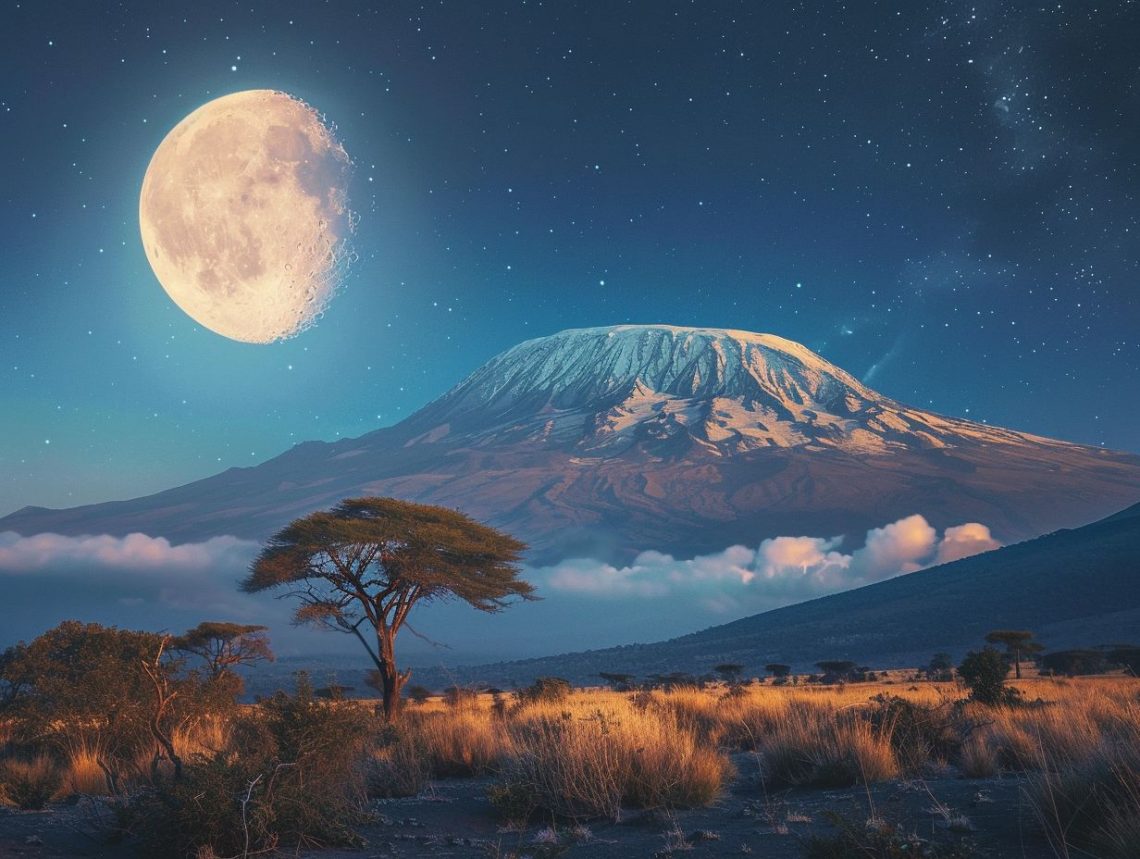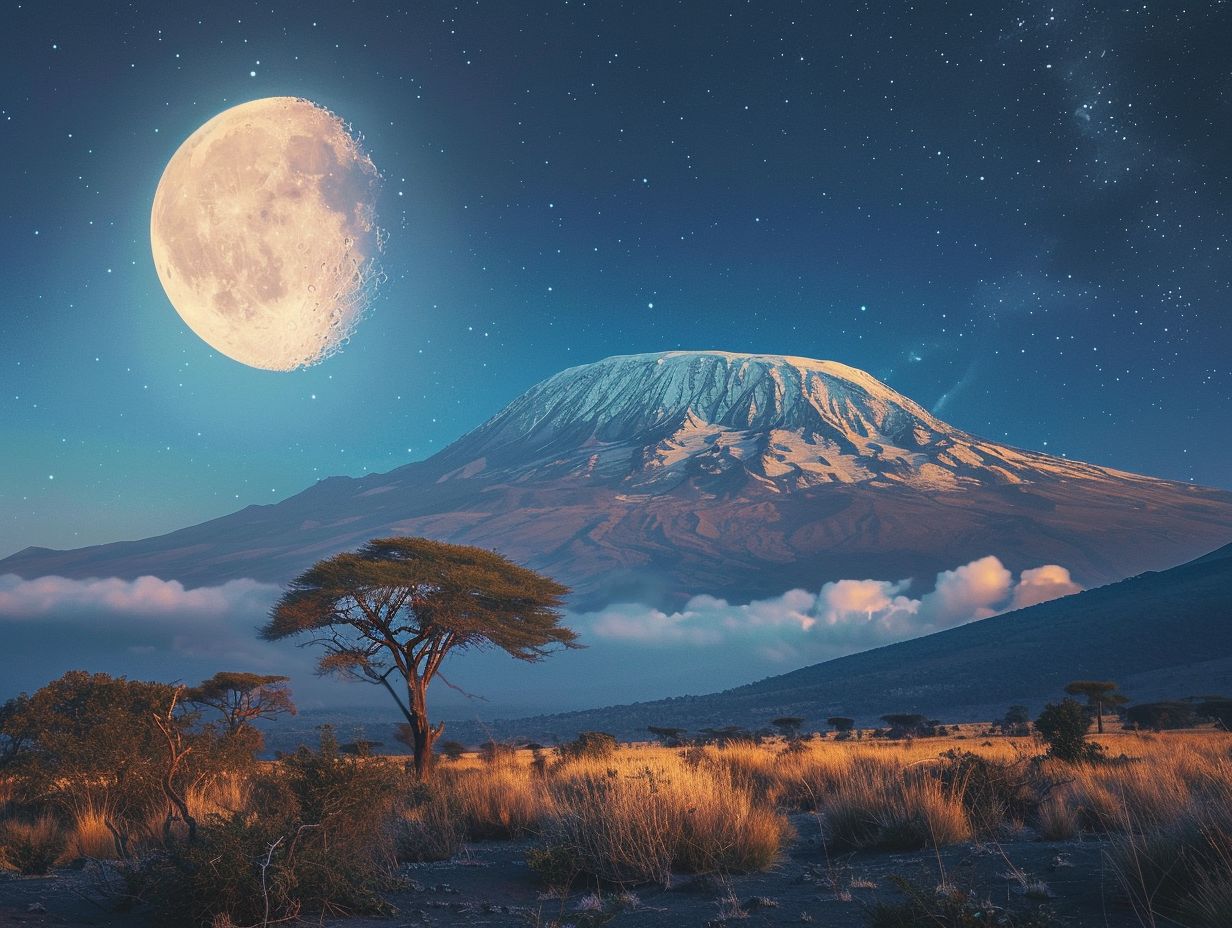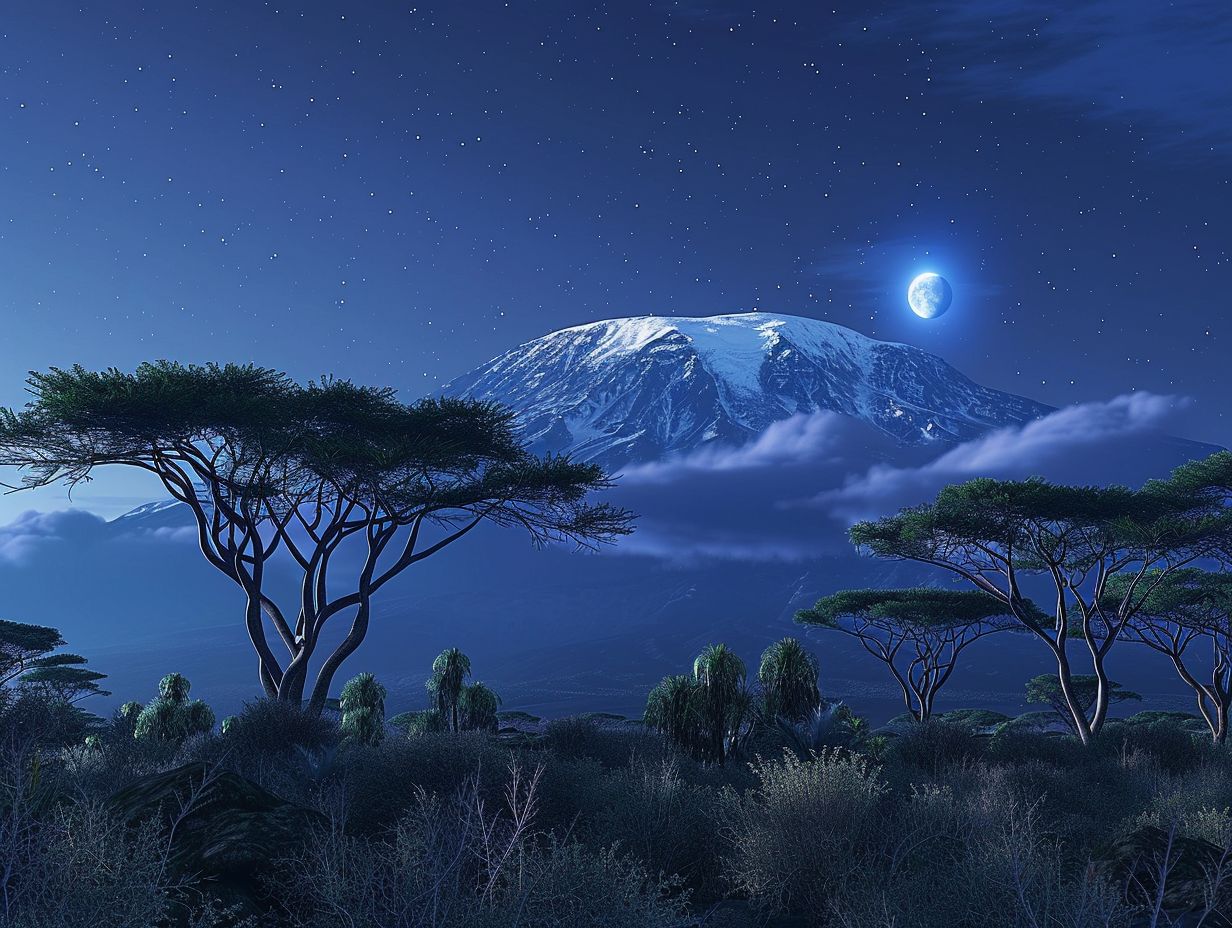
Kilimanjaro Full Moon Dates
Have you ever considered climbing Mount Kilimanjaro during a full moon? The phenomenon of Kilimanjaro Full Moon dates holds a special significance for climbers, offering both benefits and challenges.
We explore the impact of full moon dates on climbing Kilimanjaro, the best dates to plan your expedition, and how to prepare for the unique experience.
Whether you are drawn to the better visibility or cooler temperatures, this guide will help you make the most of your full moon climb.
Key Takeaways:

- Climbing Kilimanjaro during a full moon offers a unique experience with better visibility and cooler temperatures.
- However, it also comes with challenges such as higher altitude sickness risk and increased crowds.
- To prepare for climbing Kilimanjaro during a full moon, train for higher altitudes, pack appropriate gear, and acclimatize properly.
What Is The Significance Of Full Moon Dates On Kilimanjaro?
The Full Moon Dates on Kilimanjaro offer unparalleled opportunities to witness the moonrise, starlit sky, and unique celestial experiences along the journey.
During these special moon climbs, climbers are treated to the mesmerizing sight of the bright full moon and get a chance to marvel at the twinkling stars.
The enhanced visibility provided by the full moon often creates a surreal atmosphere, casting dramatic shadows on the landscapes and revealing intricate details of the terrain.
Climbers can behold other heavenly bodies such as planets, constellations, and shooting stars that make the night sky a celestial spectacle.
How Does Full Moon Affect Climbing Kilimanjaro?
The Full Moon significantly impacts the climbing experience, as the moonlight illuminates the path and enhances visibility for climbers.
Envision being enveloped in a surreal glow as the moonlight dances on the rocky terrain, guiding your way forward.
This unique illumination not only creates an unforgettable atmosphere but also serves as a crucial safety feature during the demanding trek.
Enhanced visibility allows climbers to navigate challenging sections with more ease, reducing the risk of accidents and aiding climbers in maintaining a steady pace.
Despite the advantages offered by the Full Moon, a night climb under its light poses its set of challenges.
The stark shadows cast by the moon can sometimes distort depth perception, making it trickier to judge distances or identify potential hazards.
Climbers must be prepared with the right equipment and mindset to tackle these obstacles effectively.
When Are The Full Moon Dates On Kilimanjaro?
The Full Moon Dates on Kilimanjaro vary each year, with notable occurrences scheduled in 2024 and 2025, offering climbers the chance to experience the magic of the moonlit ascent.
During these dates, the mountain is bathed in moonlight, creating a surreal atmosphere that adds an extra layer of enchantment to the climb.
Climbers can witness the natural beauty of the landscape under the soft glow of the moon, enhancing their celestial observations.
Night climbs during full moon periods provide a unique adventure, with the moon casting its silvery light on the rugged terrain.
What Are The Best Full Moon Dates To Climb Kilimanjaro?
Choosing the best Full Moon Dates to climb Kilimanjaro involves considering factors like clear skies, optimal visibility for star viewing, and expert guidance.
When planning your Kilimanjaro expedition, stellar visibility is paramount, especially during full moon climbs to fully appreciate the night sky’s grandeur.
Opting for full moon dates with minimal cloud cover increases the chances of experiencing a breathtaking celestial display.
Selecting the most suitable climbing route, such as the Machame or Lemosho routes, can significantly enhance your stargazing experience at higher altitudes.
An experienced guide like Thomas, equipped with extensive knowledge of the mountain and its celestial wonders, can offer invaluable insights and ensure a safe journey.
What Are The Benefits Of Climbing Kilimanjaro During Full Moon?

Embarking on a climb during the Full Moon offers climbers a myriad of benefits, including enhanced visibility, cooler temperatures, and unforgettable experience.
1. Better Visibility
Enhanced visibility during a Full Moon climb on Kilimanjaro provides climbers with clear, well-lit paths for their summit attempt.
Having a well-defined path illuminated not only enhances the overall climbing experience but also significantly reduces the risk of losing track or taking incorrect routes.
This improved visibility plays a crucial role in ensuring climbers’ safety by allowing them to better navigate the terrain and avoid potential hazards.
The ability to see surroundings clearly enables climbers to appreciate the breathtaking beauty of the landscape bathed in the moonlight.
2. Cooler Temperatures
Climbing Kilimanjaro during a Full Moon offers the benefit of cooler temperatures, ensuring that climbers can enjoy a more comfortable ascent.
This drop in temperature due to the moon’s influence can significantly aid climbers in managing their energy levels, reducing the risk of overheating during strenuous climbs.
The cooler environment also enhances the overall well-being of climbers, allowing them to focus more on the breathtaking views and unique experience.
Clear weather conditions during Full Moon climbs provide optimal visibility, allowing climbers to appreciate the surrounding landscape during their journey to the summit.
3. Unique Experience
Climbing Kilimanjaro during a Full Moon guarantees a unique experience that transcends the ordinary, as climbers are immersed in a celestial spectacle under the starlit sky.
With the moon casting a gentle silver glow over the rugged terrain, each step towards the summit feels like a spiritual journey guided by the cosmos.
The starry vistas above seem to whisper tales of ancient constellations, connecting the earthly realm to the heavens beyond.
As the night unfolds, the luminous display overhead paints a mesmerizing picture, filling the heart with a profound sense of awe and tranquility.
What Are The Challenges Of Climbing Kilimanjaro During Full Moon?
Despite its allure, climbing Kilimanjaro during a Full Moon presents certain challenges, including heightened risks of altitude sickness and the possibility of encountering increased crowds on popular routes.
1. Higher Altitude Sickness Risk
One of the primary challenges of climbing Kilimanjaro during a Full Moon is the increased risk of altitude sickness due to rapid ascents, necessitating proper acclimatization.
Altitude sickness with symptoms ranging from headaches to more severe forms like high altitude pulmonary edema (HAPE) and high altitude cerebral edema (HACE).
Acclimatization becomes essential in allowing the body to adjust to the decreased oxygen levels as you climb higher.
This means taking your time, following a slow and steady pace, and spending time at intermediate elevations to prepare for the demands of summit night.
It’s crucial to hydrate well, maintain a proper diet, and listen to your body’s signals to minimize the risk of altitude-related complications.
2. Increased Crowds

Another challenge when climbing Kilimanjaro during a Full Moon is the potential for encountering larger crowds on popular routes.
Managing groups in this scenario becomes crucial to ensure safety and enjoyment for all climbers.
The start time selection is critical for balancing the desire to witness the moon’s glow with the need to minimize bottlenecks.
Selecting less-traveled routes or starting off at non-peak hours can greatly enhance the climbing experience, allowing participants to savor the serenity of the moonlit ascent.
By carefully strategizing route choices and departure times, climbers can optimize their chances of a memorable and uncluttered journey to Kilimanjaro’s summit.
How To Prepare For Climbing Kilimanjaro During Full Moon?
Effective preparation is key for climbing Kilimanjaro during a Full Moon, involving training for higher altitudes, packing essential gear, and securing bookings in advance to ensure a smooth and successful expedition.

1. Train For Higher Altitudes
Training for higher altitudes is crucial when preparing for a Full Moon climb on Kilimanjaro to ensure proper acclimatization and physical readiness.
Altitude training plays a key role in helping climbers adapt to reduced oxygen levels at higher elevations, thus minimizing the risk of altitude sickness.
Incorporating activities like hiking, running, and strength training can improve cardiovascular endurance and muscle strength.
Focusing on hydration, nutrition, and rest is vital to support the body’s recovery and adaptation processes during altitude training.
Climbers must gradually increase the elevation of their training sessions to simulate the conditions they’ll face during the Full Moon climb.
2. Pack Appropriate Gear
Selecting and packing appropriate gear is essential for a Full Moon climb on Kilimanjaro, including crucial equipment like headlamps for navigating night trails.
When embarking on a Full Moon ascent of Kilimanjaro, it’s imperative to have the right equipment to tackle the challenges posed by nighttime climbing.
Apart from headlamps, key essentials include sturdy hiking boots, layered clothing, and a reliable backpack to carry essentials like water and snacks.
Carrying a first aid kit is non-negotiable for any mountain expedition, providing essential supplies for treating minor injuries or emergencies.
Investing in a quality sleeping bag and tent is also crucial, ensuring comfort and protection during overnight stays on the mountain.
3. Acclimatize Properly
Proper acclimatization is critical for climbers embarking on a Full Moon ascent of Kilimanjaro, ensuring that they adapt to altitude changes effectively.
Acclimatization involves allowing the body to gradually adjust to reduced oxygen levels at higher altitudes, preventing altitude sickness and related health issues.
Climbers need to pace themselves and take frequent breaks to aid their bodies in acclimatizing, significantly increase their chances of reaching the summit without complications.
Daytime summit attempts are preferred as they provide a better view and allow for a safer descent before weather conditions deteriorate.
4. Book In Advance
Securing bookings in advance for a Full Moon climb on Kilimanjaro is essential to guarantee accommodations, guide availability, and camp arrangements.
They encompass the coordination of camp reservations, securing experienced guide services, and careful logistical arrangements by booking in advance.
By planning ahead and making necessary bookings in advance, climbers can avoid last-minute hassles and uncertainties.
The availability of accommodations, knowledgeable guides, and proper camp setups can make a significant difference in the success and enjoyment of the climb.
Frequently Asked Questions
1. What are the full moon dates for Kilimanjaro?
A: The full moon dates for Kilimanjaro vary every month, but typically fall around the middle of the month. It is best to check a lunar calendar for the specific dates.
2. Why are full moon dates important for climbing Kilimanjaro?
A: Full moon dates are important for climbing Kilimanjaro because they offer better visibility during night hikes and add a unique experience to the trek.
3. Are there any special events or traditions during Kilimanjaro full moon dates?
A: Yes, there are often special events and traditions during Kilimanjaro full moon dates, including moonlit celebrations and cultural performances by local guides and porters.
4. How can I find out the full moon dates for Kilimanjaro?
A: You can find out the full moon dates for Kilimanjaro by consulting a lunar calendar, checking with your tour operator, or researching online.
5. Do full moon dates affect the difficulty of climbing Kilimanjaro?
A: Full moon dates can affect the difficulty of climbing Kilimanjaro, as the brightness from the moon can make certain sections of the hike more challenging. However, experienced guides are well-equipped to handle these conditions.
6. What should I bring for a Kilimanjaro trek during full moon dates?
A: Along with your regular packing list for a Kilimanjaro trek, it is recommended to bring a headlamp or flashlight, as well as warm layers for night hikes during full moon dates. It may also be helpful to bring a camera to capture the stunning views.